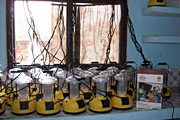Globally over 2 billion people have little or no access to energy services and rely on traditional biomass to meet their daily energy requirements. In global energy terms, this consumption is greater than all other types of renewable energy (including wind, solar, hydropower and modern bioenergy) combined.

The energy insecurity and climate impacts of dependence on traditional biomass require more analysis within the local context, in order to address the needs of the poorest citizens while also identifying low-GHG options. The burning of traditional biomass results in incomplete combustion of various gases and particles, including methane and soot or black carbon, which are powerful short-lived climate forcers. The provision of higher quality energy services might therefore be combined with climate measures.

This project includes scoping analysis and methodological studies as well as policy dialogues addressing selected topics and stakeholders in India, Tanzania and Malawi. The goal is to consider policy approaches, resource scenarios and assessment methods that might better illustrate linkages between energy access and climate objectives, so as to provide useful co-benefits in the transition away from traditional biomass use.
Some biomass used for household cooking is “non-renewable” in those regions where demand exceeds sustainable yield and/or improvements in methods for extraction and conversion of wood fuel have not kept pace with the increased demand. The climate effects of non-renewable biomass will be higher in some regions than the climate effects from emissions in the fuel cycle. Improved methods for comparing the relative contributions are needed.

The use of more efficient cook stoves and switching to cleaner fuels such as LPG, ethanol or electricity has been promoted in some areas as a way to simultaneously contribute to improved energy access and reduce GHG emissions. However, such fuels and stoves are not necessarily easily available nor are they integrated into socio-economic and cultural contexts at local or regional level; consequently, they may impact negatively on livelihoods or socio-economic priorities. Consumer acceptance must be addressed in order to avoid a technological bias in the design and implementation of cook stove initiatives. Models of consumer choice, market segmentation, and other behavioural studies can be quite useful in this respect.
Stated preference methods and choice experiments can be used to assess the willingness of consumers or households to pay for clean cooking options that are not yet available, while revealed preference or user studies can be used to evaluate the performance and acceptance of those stoves already on the market. Econometric approaches can allow quantitative measurements of willingness to pay, particularly discrete choice methods. Other techniques can include various market segmentation or market forecasting studies. Another set of techniques are spatially-based methods that can combine data on the physical availability of wood fuels and biomass with demand for different stoves. Such approaches can contribute to better design of cook stove programmes and help stimulate a market transformation towards cleaner and more efficient cook stoves.
Design and development by Soapbox.



